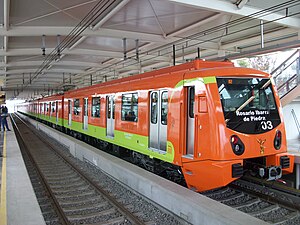FE-10 (Mexico City Metro)
| FE-10 | |
|---|---|
 FE-10 in Line 12 of Mexico City Metro. | |
| In service | 2012–present |
| Manufacturer | CAF[1] |
| Entered service | 30 October 2012 |
| Number built | 210 cars (30 trains) [2] |
| Formation | 7 cars per trainset[2] |
| Capacity | 1471[1] |
| Operators | STC |
| Lines served | |
| Specifications | |
| Car body construction | (?) |
| Train length | 141 m (463 ft) |
| Car length | (?) |
| Width | (?) |
| Height | (?) |
| Maximum speed | 90 km/h (56 mph)[1] |
| Power output | 4,065 kW (5,451 hp) |
| Electric system(s) | Catenary 1.5 kV DC[3] |
| Current collector(s) | Pantograph |
| Track gauge | 1,435 mm (4 ft 8+1⁄2 in) standard gauge |

The FE-10 (abbreviated from the Spanish: Férreo Español 2010) is a steel-wheeled model of electrical multiple units used on the Mexico City Metro, first used in 2012 and currently servicing Line 12.[2]
Conception
In 2009, while Mexico City Metro Line 12 was still under construction, Spanish Construcciones y Auxiliar de Ferrocarriles (CAF) was awarded the contract to supply 30 trains of seven cars each for Line 12 for an approximate amount of 1000 million euros.[4]
CAF had previously supplied trains for the Mexico City Metro such as the NE-92 and NM-02.[5][6]
Description
The FE–10 currently services Line 12 only. Each train is equipped with vehicle control and monitoring system, ATP-ATO automatic driving system, passenger information and video entertainment systems, CCTV and saloon and cab ventilation systems.[1]
The entire length of a train is 141 meters (463 ft).[2][3]
In 2015, Technischer Überwachungsverein, made a recommendation to STC to change the trains due to certification problems that mainly affect an excessive wear for the steel wheels and the rails.[7]
Technical specifications
- Train length: 90.390 m (296 ft 6+5⁄8 in)
- Overall width: 2.400 m (7 ft 10+1⁄2 in)
- Height of a train car above the running surface: 3.485 m (11 ft 5+1⁄4 in)
- Floor height above the running surface: 1.180 m (46.46 in)
- Weight in running order: 126.4 tonnes (124.4 long tons; 139.3 short tons)
- Maximum capacity (at four travelers / m2): 700 passengers including 144 seats
- Folding seats available off-peak: 146
- Maximum speed: 85 km/h (53 mph)
- Maximum power: 4,065 kW (5,451 hp)
- Average acceleration of 1.2 m/s2 (3.9 ft/s2)
- Maximum braking normal steady state: 2 m/s2 (6.6 ft/s2)
Train names
Out of the 30 trains in service, nine of them have been named, honoring several prominent Mexican people from the 20th century.[2]
| No. | Name | Opening date |
|---|---|---|
| 1 | Ing. Cuauhtémoc Cárdenas Solórzano | 15 March 2012 |
| 2 | Rosario Ibarra de Piedra | 12 June 2012 |
| 3 | Elena Poniatowska | 19 June 2012 |
| 4 | Dr. Mario Molina Premio Nobel | 29 June 2012 |
| 5 | Antonio Enríquez Savignac (†) | 19 July 2012 |
| 6 | Arq. Teodoro González de León (†) | 22 August 2012 |
| 7 | Arq. Ricardo Legorreta (†) | 25 September 2012 |
| 8 | Carlos Fuentes (†) | 21 November 2012 |
| 9 | Valentín Campa Salazar (†) | 14 February 2013 |
References
- ^ a b c d "Metro México Line 12". CAF.net. CAF. Retrieved 23 March 2020.
- ^ a b c d e "FE-10" (in Spanish). Metro CDMX. Retrieved 23 March 2020.
- ^ a b "Caracteristicas Trenes FE-10". cmt-l12.com (in Spanish). Retrieved 23 March 2020.
- ^ "CAF is awarded the contract to supply 30 units for the Mexico City Metro". CAF.net. CAF. 12 January 2010. Retrieved 23 March 2020.
- ^ "METRO MEXICO NE-92". CAF.net. CAF. Retrieved 23 March 2020.
- ^ "METRO MEXICO NM-02". CAF.net. CAF. Retrieved 23 March 2020.
- ^ "Empresa que rehabilita Linea 12 sugiere cambiar los trenes". Eje Central (in Spanish). 20 January 2015. Retrieved 23 March 2020.
